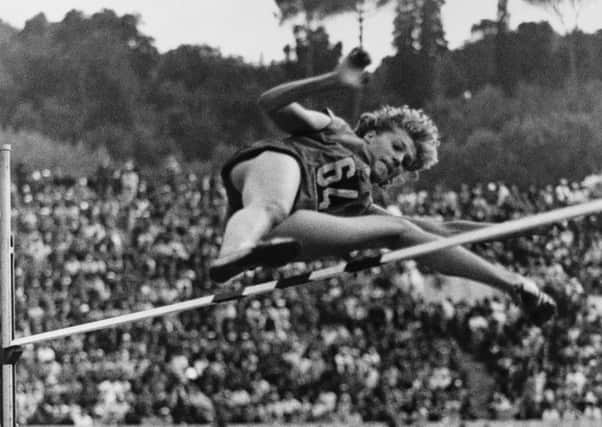Obituary: Iolanda Balas, Romanian athlete


Romanian athlete Iolanda Balas who has died aged 79 can lay claim to be the world’s most successful female high jumper of all time.She totally dominated the event from 1956 to 1967, recording 150 consecutive wins,setting 14 world records and winning two Olympic and two European titles.She is the only female high jumper to win consecutive Olympic golds, in Rome 1960 and Tokyo in 1964 and it was fitting that in 2000 the prestigious American athletics magazine Track and Field News declared her “the best female high jumper of the 20th century”.
The scale of her dominance was breathtaking and eclipses that of other famous athletes, such as Ed Moses’122 consecutive wins in the 400m hurdles and Carl Lewis’ 65 consecutive successes in the long jump. She won her 1960 0lympic title by a margin of 14cm,the greatest ever in global competition, and in 1964 by 10cm.
Advertisement
Hide AdAdvertisement
Hide AdOn 18 0ctober 1958 in Bucharest, she became the first woman ever to clear 6 ft[1.83m], a leap that would not be emulated till 1964,by Michele Brown of Australia. Her final world record set on 16 July 1961 in Sofia of 6’ 3¼” [1.91m] stood till 1971 when Austrian athlete Ilona Gusenbauer edged it by 1cm.
And all this was achieved by her using a version of the old fashioned “scissors” technique, a markedly less effective style than the contemporary and more favoured western roll or straddle methods. Although the Fosbury Flop which revolutionised the event did not feature till the 1968 Olympics, a year after her retirement, her world record remained intact for three years after.
She first came to international prominence in 1954 when winning silver at the European Championships in Berne as a 17 year old. In July 1956 she set her first world record making her favourite for the Melbourne Olympics later that year. However, the Romanian communist regime would not permit her coach, Janos Soter, to accompany her as he had a brother settled in Australia and it was feared he might defect. Disadvantaged by his absence, she could only finish fifth. On her return home she was criticised for her performance, it even being suggested by some that she had lost deliberately which only made her more determined to win Olympic gold.
Born in Timisoara to a family of mixed Romanian and Hungarian descent, she was first encouraged in high jumping as a youngster by former high jumper Luisa Ernst, the caretaker of the block of flats where her family lived. She joined the local Electrica club and won her first national title, of 16 consecutive ones, in 1951.Her potential having been identified, she moved to Bucharest in 1953 where she joined the famous Steaua club and began to be coached by Soter, reckoned to be one of the world’s best. He also had a good pedigree as a high jumper, holder of the national record and 6th in the Helsinki Olympics. Under his guidance she flourished and embarked on her singularly successful career.
Her Tokyo Olympic win was secured despite troublesome ankle and Achilles problems which were to continue and prevent her taking part in the 1966 European Championships. Her aim had been to compete in the 1968 Mexico Olympics but the loss of her unparalleled winning run in 1967 and ongoing injury worries led to her retiring that year. In a later interview, referring to her dominance, she stated: ”Sometimes it was hard to compete, there was no opposition for me.” After she retired she married her coach, did some coaching herself and taught physical education in Bucharest. She also became involved in the administrative side of athletics and from 1988 to 2005 was president of the Romanian athletic federation as well as vice-president of her country’s Olympic committee for several years.
Although always identified with Romania, she felt a strong association with Hungary where her father reportedly lived after being captured by the Russians during the war. In a 2005 interview she was asked whether she had ever considered defection and admitted she had but did not take it further because of fear of retaliation against relatives. She also commented: ”I feel sorry I did not win the Olympics for Hungary but a person represents herself and then a nation. It wasn’t given for me to wear the Hungarian colours to make happy those who speak my mother tongue.”
There was also a suggestion she found fame difficult to handle. ”It is not easy to be a star, I put up with my fame as a necessary evil, always striving to keep up with expectations.”
Her standing in world athletics was underlined when in 2012 she was inducted into the IAAF’s inaugural Hall of Fame along with other all time greats, such as Jesse Owens,Emil Zatopek,Al Oerter,Carl Lewis and others.
Advertisement
Hide AdAdvertisement
Hide AdRomanian athletics president Ion Sandu described her as “the greatest Romanian athlete of all time” while Gabriele Szabo,the Romanian Olympic 5,000 m gold medallist commented:”It is a sad day for me,she was my mentor.A great person has died.”